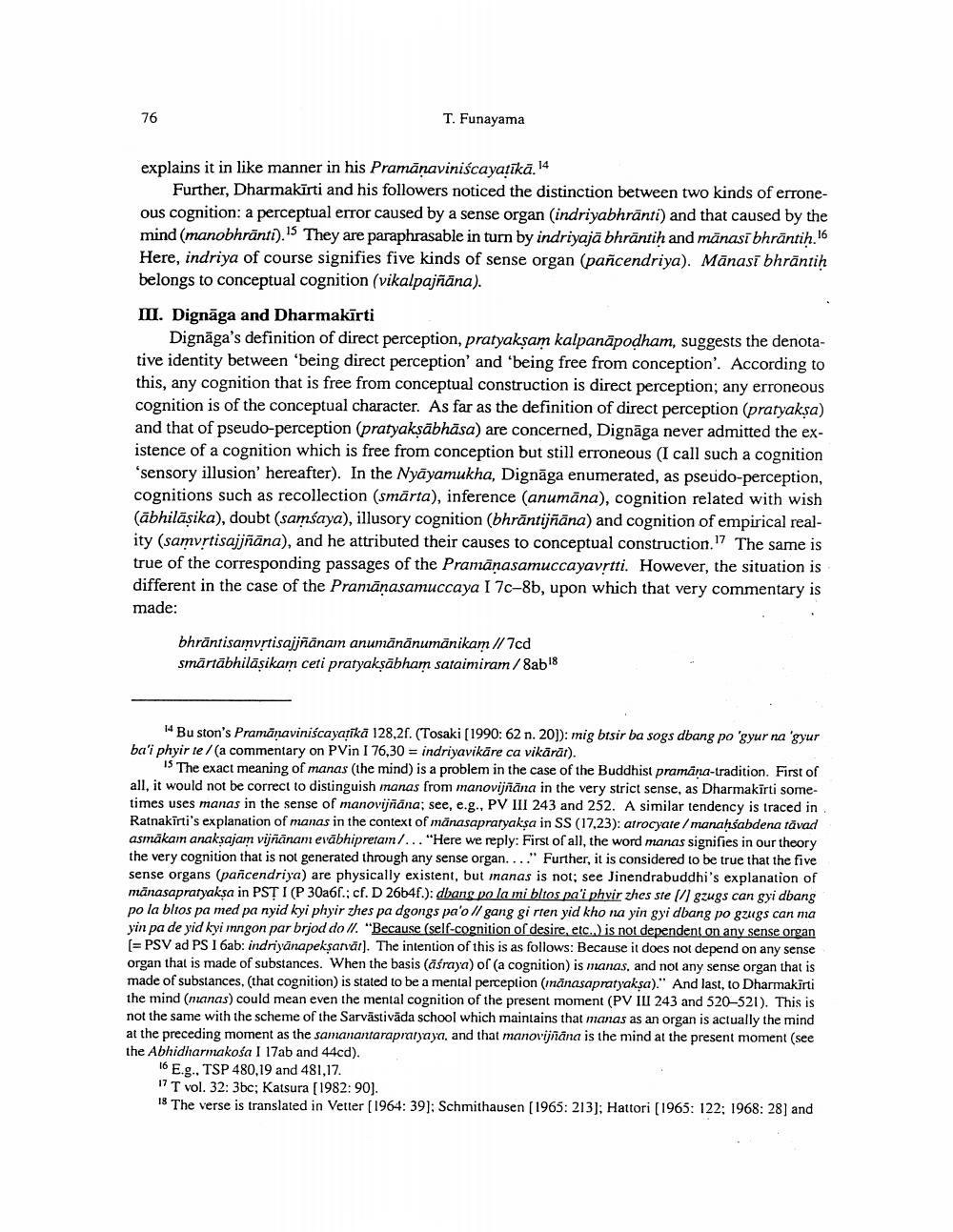________________
T. Funayama
explains it in like manner in his Pramanaviniścayatīkā. 14
Further, Dharmakīrti and his followers noticed the distinction between two kinds of erroneous cognition: a perceptual error caused by a sense organ (indriyabhrānti) and that caused by the mind (manobhrānti).15 They are paraphrasable in turn by indriyajā bhrāntiḥ and mānasi bhrāntih. 16 Here, indriya of course signifies five kinds of sense organ (pañcendriya). Mānasi bhrāntih belongs to conceptual cognition (vikalpajñāna). III. Dignāga and Dharmakīrti
Dignāga's definition of direct perception, pratyakşam kalpanāpodham, suggests the denotative identity between 'being direct perception' and 'being free from conception'. According to this, any cognition that is free from conceptual construction is direct perception; any erroneous cognition is of the conceptual character. As far as the definition of direct perception (pratyakşa) and that of pseudo-perception (pratyaksābhāsa) are concerned, Dignāga never admitted the existence of a cognition which is free from conception but still erroneous (I call such a cognition 'sensory illusion' hereafter). In the Nyāyamukha, Dignāga enumerated, as pseudo-perception, cognitions such as recollection (smärta), inference (anumāna), cognition related with wish (ābhilāşika), doubt (samśaya), illusory cognition (bhrāntijñāna) and cognition of empirical reality (samvrtisajjñāna), and he attributed their causes to conceptual construction. The same is true of the corresponding passages of the Pramānasamuccayavrtti. However, the situation is different in the case of the Pranānasamuccaya I 7c-8b, upon which that very commentary is made:
bhrāntisamvrtisajjñānam anumänänumänikam //7cd smärtäbhiläşikam ceti pratyaksābham sataimiram / 8ab18
14 Bu ston's Pramāņaviniscayaţika 128,21. (Tosaki (1990: 62 n. 20]): mig btsir ba sogs dbang po 'gyur na 'gyur ba'i phyir te/(a commentary on PVin I 76,30 = indriyavikäre ca vikärät).
15 The exact meaning of manas (the mind) is a problem in the case of the Buddhist pramana-tradition. First of all, it would not be correct to distinguish manas from manovijñāna in the very strict sense, as Dharmakirti sometimes uses manas in the sense of manovijñāna; see, e.g., PV III 243 and 252. A similar tendency is traced in Ratnakirti's explanation of manas in the context of mănasapratyaksa in SS (17,23): atrocyate / manahsabdena tävad asmäkam anaksajam vijñānam evābhipretam/... "Here we reply: First of all, the word manas signifies in our theory the very cognition that is not generated through any sense organ...." Further, it is considered to be true that the five sense organs (pancendriya) are physically existent, but manas is not; see Jinendrabuddhi's explanation of mānasapratyaksa in PSTI (P 30a6f.,cf.D 26b4f.): dbang po la mi bltos pa'i phvir zhes ste ( gzugs can gyi dbang po la bltos pa med pa nyid kyi phyir zhes pa dgongs pa'o Il gang gi rten yid kho na yin gyi dbang po gzugs can ma yin pa de yid kyi mngon par brjod do II. "Because (self-cognition of desire, etc..) is not dependent on any sense organ (= PSV ad PS I 6ab: indriyānapeksanvāt). The intention of this is as follows: Because it does not depend on any sense organ that is made of substances. When the basis (aśraya) of (a cognition) is manas, and not any sense organ that is made of substances, (that cognition) is stated to be a mental perception (mānasapratyakşa)." And last, to Dharmakirti the mind (manas) could mean even the mental cognition of the present moment (PV II 243 and 520-521). This is not the same with the scheme of the Sarvāstivāda school which maintains that manas as an organ is actually the mind at the preceding moment as the samanantarapratyaya, and that manovijñāna is the mind at the present moment (see the Abhidharmakosa I 17ab and 44cd).
16 E.g., TSP 480,19 and 481,17. 17 T vol. 32: 3bc; Katsura (1982: 90). 18 The verse is translated in Vetter (1964: 39]: Schmithausen (1965: 213): Hattori (1965: 122: 1968: 28] and




